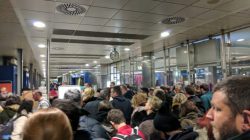This article is part of a longer series on where travel might be going in the next 15-20 years (More Connectivity, Thinner Routes, Premium Traffic, On the Ground and Differentiated Experiences). Yes, it’s speculative, but hopefully some of these ventures get some lively conversations started.
Okay, so I’m writing this one after sweating a battlefield upgrade on Alaska back from Honolulu, so I’m feeling sporting and willing to venture into treacherous territory ?
So let’s talk about autonomous flights! — pilotless planes
Too dangerous? Never going to pass regulatory muster? The future may be sooner than you think.
Drones are currently being piloted and flown all over the world… from New Mexico. Fedex and DHL are exploring remote piloting bases to reduce costs.
On passenger flights, crew are often 1/3 of the cost of your ticket – with pilots roughly half of that. Certainly there are safety concerns allayed by having a pilot and a backup pilot onboard — but consider the idea that you could have crew assisting from afar, putting in 8 hour shifts managing a number of flights mid-trip, while a co-pilot is still onboard to handle take off and landing or irregular flight operations.
Yes, many corrections happen inflight that are never logged and pilots still play an important role in the governance of a plane’s operations. But as statistics get increasingly accurate, pilot error becomes a non-insignificant factor in overall airline safety and having more eyes on a plane — especially well-rested eyes — working a standard 8-hour day on their own timezone will likely reduce those numbers.
Would connectivity be an issue? Perhaps, but transoceanic wifi is becoming a standard and certification processes similar to ETOPS could come into fruition. While worldwide connectivity is further off — crew rest could be timed with segments that are well-covered over populated areas.
What about physical safety? Would crew not on the plane be able to lock out and override people onboard in the event of a terrorist attack or psychological issue? This may be a good safeguard in the cases of a cockpit breach or incapacitated crew.
Drone technology will continue to improve, both human-piloted and autonomous. It’s only inevitable that the aircraft of the future will have fewer people involved in driving it. When will a drone manufacturer make a big enough model for a person to ride in? Without driving it?
If you’re still skeptical, consider that autonomous cars have only two dimensions to work with, and while they aren’t perfect, they tend to do just fine on the highway — about as good, if not better than your average driver (who can get sleepy or distracted by a sandwich or video on their phone). While air traffic near hubs can be busy (and could also be double-checked on the ground), generally planes have far fewer obstacles to hit and a fairly “direct” trajectory during most of their journeys.
I’ve floated this by a few friends in the airline industry and they’re understandably cautious, but I could see low-cost carriers in less strict regulatory environments being the first to implement the idea. The most likely launch markets would be island chains or remote outstations, where staffing for 1-2 flights per day would be extraordinarily inefficient — Scandinavian airports north of the arctic circle, Alaskan oil outposts, Australian mines or perhaps remote portions of Siberia.
So I’m optimistic — semi to fully autonomous passenger aircraft will eventually make my airfare even cheaper (though I just snagged another $400 roundtrip from California to Europe) and may protect against fatigue or pilot error, making my flights safer and more consistent. A pilot on a regular 8 hour shift, suffering no jetlag is probably safer than one doing a quick turn on a few hours of sleep – provided the connection to the aircraft is solid.
How do you feel? I realize this is a controversial topic, but it’s probably inevitable over the next 20 years. Let the bloodbath begin Leave your thoughts below!



